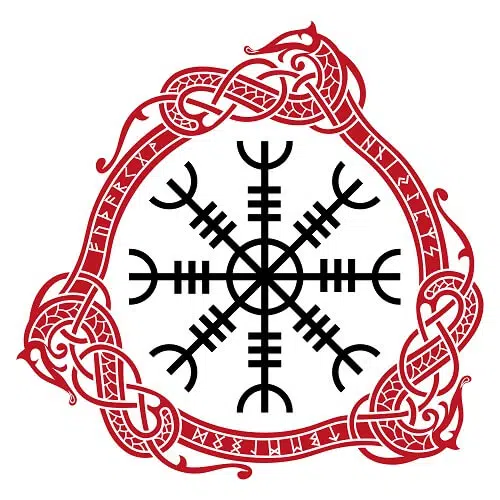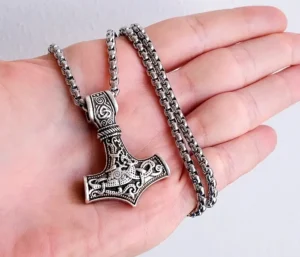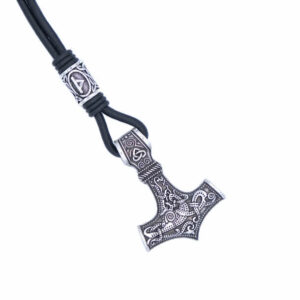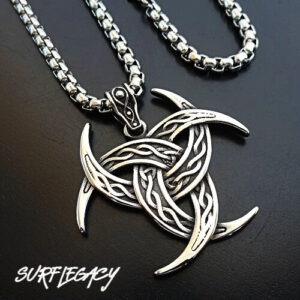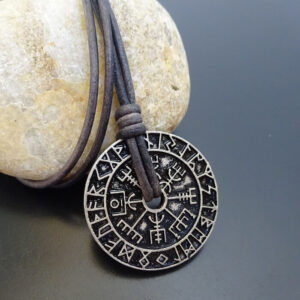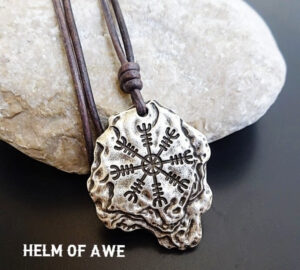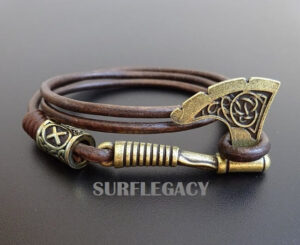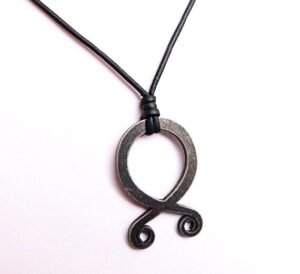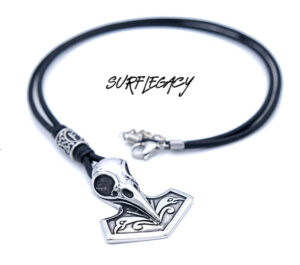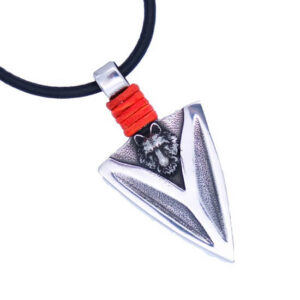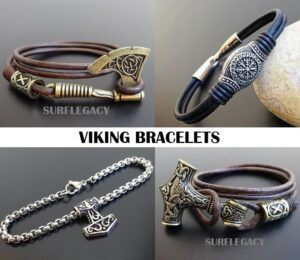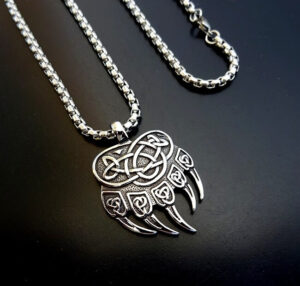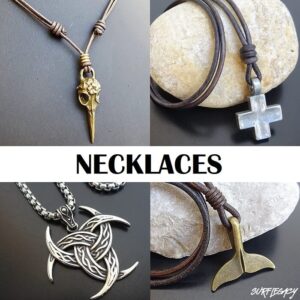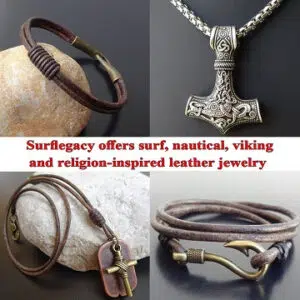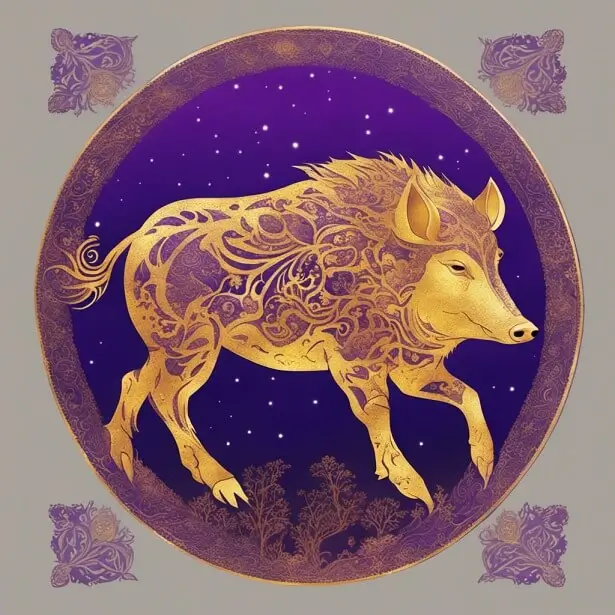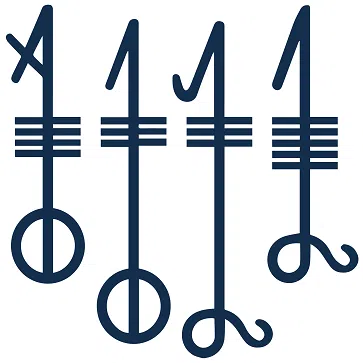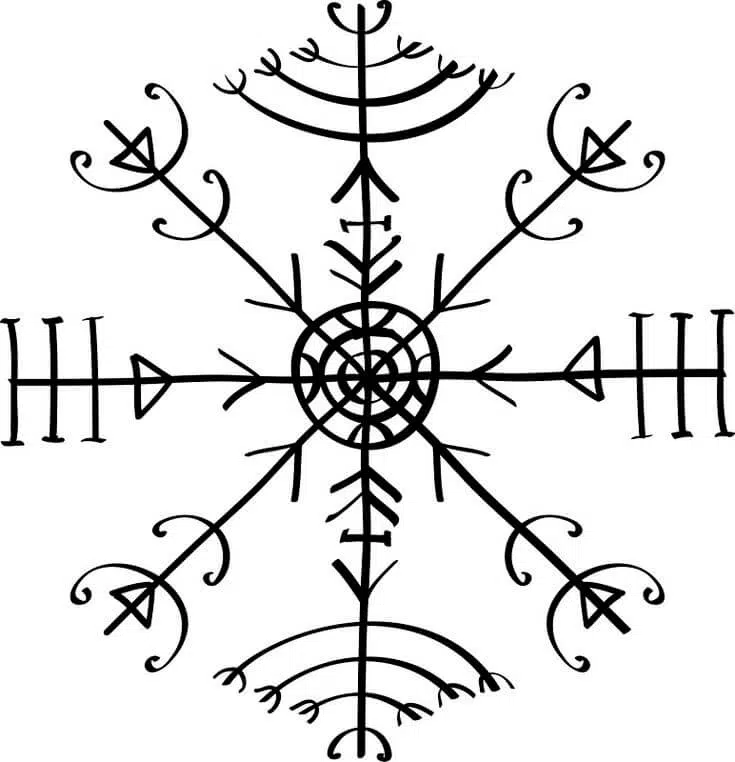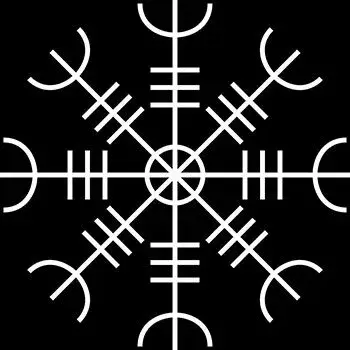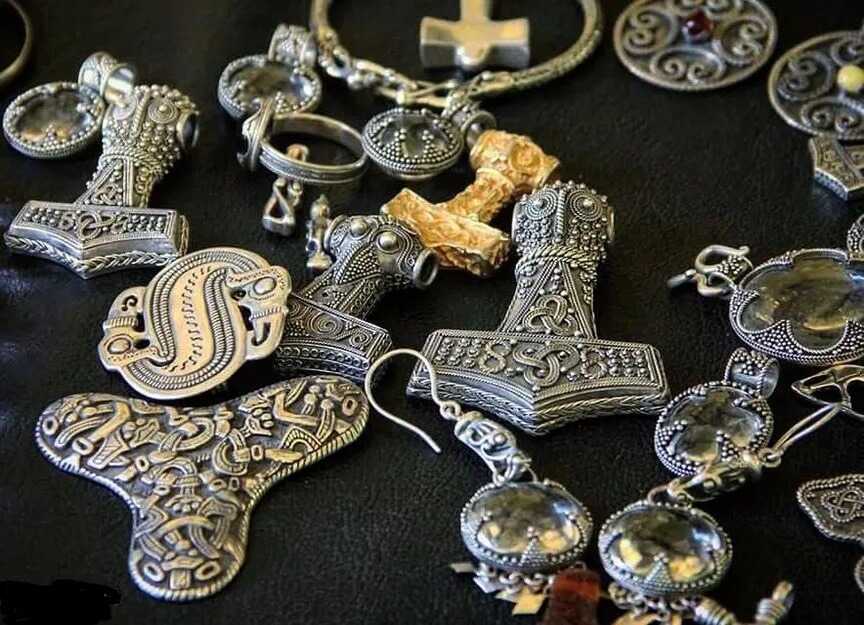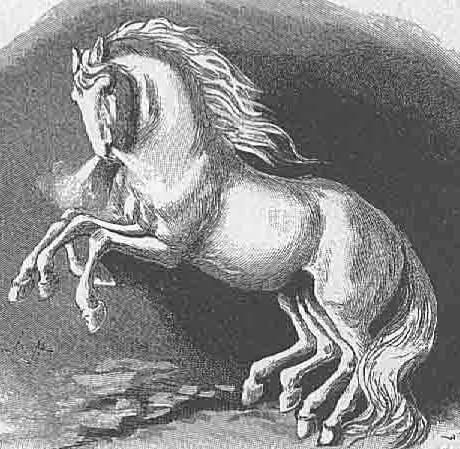The culture of the Nordic or Viking population has always been considered one of the most fascinating. Merit surely of the valiant deeds in battle, and of the numerous conquests obtained thanks to the wise experience in navigation.
One of the distinctive features of the Norse is the symbology, rich in meanings and many evocative symbols, in fact, had a specific and very deep meaning, the Viking symbols are now much studied and back in vogue for the realization of various esoteric objects.
Currently, the Nordic culture is living in a period of great interest, thanks to TV series, movies, and games in vogue in the last years and its symbols seem to be perfect to be imprinted on the skin.
Viking Symbols Meanings
1. Mjolnir aka Thor’s Hammer
Among the most famous Viking symbols, there is definitely the Mjölnir, and for this reason, we decided to put it first on the list.
In the Viking culture, it was a symbol of protection in battle, but few know that Thor also used his hammer to bless couples and wish them fertility, and consecrate people into gods. For sure one of the most powerful and popular symbols associated with the Vikings.
Mjolnir Creation
One day, the god Loki decided to play a prank on Thor and his wife Sif, cutting off her beautiful blonde hair. Obviously, Thor did not take it well and went on a rampage, so Loki to make up for Thor’s anger, promised that he would ask the dwarves to make new hair for his wife Sif even more beautiful.
Loki instead of simply asking the dwarves to make new hair decided to make a bet with the dwarf Brokkr claiming that his brother, the blacksmith Sindri, was not able to produce artifacts as prodigious as those made by the Sons of Ivaldi, another family of dwarves known for having forged the magical spear Gungnir.
One characteristic of the Mjolnir was its short handle, this was because, during the forge, the trickster god Loki turned into a fly and came to distract the dwarf while he was crafting the weapon.
However, the mistake did not disadvantage the god, who instead, was not only able to handle the weapon better, but also could throw it with one hand.
Thor’s hammer is the most powerful weapon of the gods, and therefore symbolizes the protection of the universe against the forces of chaos, especially the giants, the greatest enemies of the gods, and with ith the power of his hammer, Thor regularly slaughters them
Moreover, Mjölnirs have been discovered at Norse archaeological sites and in many Viking tombs. Mjolnir was so important to Viking culture that even after they had converted to Christianity, Vikings continued to wear them along with crosses.
Today, Reproductions of Mjöllnir are sold in jewelry stores and worn by a variety of people: from scholars of Norse mythology to lovers of ancient Scandinavian history; they are also very popular among fans of Scandinavian heavy metal music and neo-pagan movements.
2. Triskele Triple Horn of Odin
The “Triple Horn of Odin”, also called trisquell, triskelion or triskel is a Viking symbol made of three interlocking spiral horns, representing the three horns of the myth of Odin and his quest for the magical mead, also known as the Mead of Poetry.
The names of the 3 horns were Óðrœrir, Boðn and Són. These horns contained mead from the time when the dwarves Fjalar and Galar killed a wise man named Kvasir born from the saliva of the Æsir and Vanir.
Kvasir who knew everything and could answer any question. The two dwarves killed him, mixed his blood with honey and poured the drink into the 3 horns.
According to the myth, Odin used his spirit to convince the giantess Gunnlöð, bargaining with her to receive a sip of mead for three days.
He was only allowed to have one sip per day, but he managed to drink one whole horn each time, thus managing to drink the entire content of the 3 horns (Mead of Poetry), which helped him escape, giving him the shape of an eagle.
Today, in addition to identifying itself as Norse, Odin’s threefold horn is used as a symbol of wisdom and inspiration, particularly for poetic inspiration.
3. Valknut Odin’s Knot
Valknut is one of the most important and fascinating Nordic symbols, also known as Odin’s knot, the father of the gods in Germanic and Norse mythology.
According to scholars, the three triangles represent hell, heaven and earth. The nine points of the triangles, on the other hand, represent the 9 worlds of ancient Norse mythology.
The name is derived from the words “valr,” meaning “slain warrior,” and “knut,” meaning “knot.” As a result, “Valknut” translates as “The Killed Warrior’s Knot.” It is also known as the heart of Hrungnir and the heart of Vala. It is thought to be the symbol of Odin.
This is not surprising, as Odin is not only the supreme Norse god, but also the god of war and death in Norse mythology.
Valknut is often depicted with Odin’s symbols, ravens or wolves, which were his constant companions, in numerous archaeological finds. This also proves that this sign belongs to Odin and is related to death in battle.
The three intertwined triangles, in fact, have been found in engravings next to warriors who died bravely. The most accredited theory is that it served to protect the spirit of the valiant so that they could reach Valhalla undisturbed to practice the arts of war until the day of Ragnarok.
For the Norse people, in fact, would come a kind of “universal judgment”, precisely the Ragnarok, during which the forces of the order would fight against the forces of chaos to destroy this world and give rise to a new cycle of rise and destruction.
The most valiant warriors, once dead, would have to train relentlessly to allow good to triumph over evil and thus ensure a bright future for the world.
Another meaning of this symbol was related to Odin and the fact that he was able to untie the human mind from its bonds and make it inclined to the divine.
On the contrary, it could induce men to madness, making them powerless and helpless, especially in case of battles. This symbol, therefore, also represents Odin’s ability to make human minds move according to his will.
It should be kept in mind that all the information we have about this symbol is only theories. Odinist scholars, on this issue, still have many doubts and almost no certain answers.
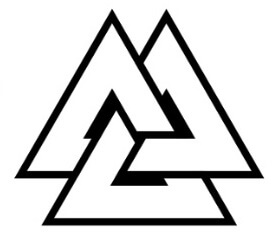
4. Vegvisir the Viking Compass
Widely associated with Aegishjalmr or sometimes even confused with it because of the similarity between the two, the Vegvisir is another Viking symbol of uncertain origins.
The word comes from the Norse and means “signpost”: Veg is derived from “Vegur” meaning “road”, “path” and “Vísir” means “indication”, “guide”.
It can be translated as follow “That which shows the way” and for this reason is also called Viking compass or runic compass. Vikings strongly believed in symbols, as they had no other means of being assisted during their navigations and the Vegvisir was one of them. They thought that it could help them during long journeys.
it is believed to provide guidance for a person who might lose their way. This symbol was apparently drawn on Viking ships, before they sailed, to ensure that the crew would return home safely
Historically, this design was found in the Huld Manuscript, written by Geir Vigfússon (1813-1880) in 1860, which is almost certainly a copy taken from various earlier sources, unfortunately, lost
That being said, there is some confusion about the origin of the symbol and whether or not it is an actual symbol inherited from the Viking Age, as there are very few resources that mention it
It is important to note that nowadays circular variants, sometimes accompanied by the alphabet of runes, are the most widely used, although the original versions were square in shape and without runes.
5. Aegishjalmr – Helm of Awe a Symbol of Protection
Like the Vegvisir, also the Ægishjalmur was found inside an Icelandic manuscript dating back to 1600: the Galdrabòk, a book containing 47 spells, seals and formulas, whose original copy has been passed from hand to hand during the years and now it is in the Royal Academy of Sciences in Stockholm, Sweden.
According to tradition, this seal was drawn (usually with blood) on the shields of warriors so that it would instill fear in the opponent and at the same time guarantee protection to those who wore it and for the same reasno it was also drawn on the forehead of soldiers.
Unlike the Vegvisir, the Aegishjalmur is mentioned in the sagas, and for this reason, there is the possibility that it could have been used in the Viking period, although probably not with the same form we know today
So as with the Vegvisir, even for this magical sigil, we do not have absolute certainty that the Vikings, used it.
Anyway, we find mentioned the Ægishjalmur by Snorri in the Fáfnismál, a saga of the poetic edda, where the dragon Fafnir finds a lot of strength and invincibility thanks to the use of the Helm of Awe:
The Helm of Awe
I wore before the sons of men
In defense of my treasure;
Amongst all, I alone was strong,
I thought to myself,
For I found no power a match for my own
Also in the collection of Icelandic folk tales collected by Jón Árnason in the nineteenth century, this sigil is mentioned in an incantation, which reads: to instill fear in enemies, draw the guiding mark between the eyebrows and pronounce the spell:
Ægishjálm er ég ber
milli brúna mér!
I bear the helm of awe
between my brows!
A Helm of Awe necklace would make a great gift for someone who is going on a trip to an unfamiliar or unsafe place and needs protection.
It is also a great symbol to inspire courage in those who may be suffering from anxiety or depression or are going through a difficult time in their life.
6. Viking Runes
Viking runes originated from the oracle of Odin, the mythological god of war, wisdom and death.
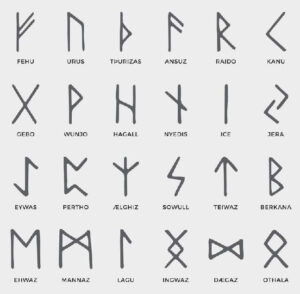
Tradition has it that Odin, the God of the Aesir, hung himself on the tree of the world, Yggdrasil, with a spear stuck in his side, for nine days and nights in order to acquire the knowledge of the runes.
When the runes appeared “underneath him”, he bent down and gathered the runic knowledge from them. He later passed this knowledge on to the goddess Vanir Freya in exchange for the Seidr. Heimdall later taught the secrets of the runes to mankind
Runes are nothing more than small stones on which were engraved symbols that symbolized facts, situations, and characters.
So far there is no evidence that the runes were used to write texts: they, in fact, were used as an oracle, Since the Vikings gave the runes magical powers, engraving them on jewelry, shields or swords was a common practice, because they thought they would protect them by ensuring their victory in battle.
At first, in Celtic culture, there were only 16 runes, with vertical or diagonal lines. This alphabet was called Younger Futhark
Later, the Scandinavians added eight more signs, eventually resulting in 24 runes and this alphabet is named Elder Futhark
The meaning of each rune can be summarized as follows
ALGIZ Protection, Defense
ANSUZ Odin Rune, God, Communication
BERKANA Femininity, Fertility, Birth
DAGAZ Dawn, Awakening, Awareness, Illumination, Hope
EHWAZ Transportation, Movement, Progress
EIHWAZ Balance, Reliability, Dependability
FEHU Wealth, Abundance, Success
GEBO Gift, Balance, Generosity
HAGALAZ Wrath of Nature, Being Tested
INGUZ, Growth, Change, Common Sense
ISA Clarity, Stasis, Introspection, Watching & Waiting
JERA A Time of peace and happiness, fruitful season
KENNAZ Vision, Creativity, Knowledge
LAGUZ Water, Intuition, Emotions, Flow
MANNAZ Humanity. Individuality, Friendship, Cooperation
NAUTHIZ Need, Restriction, Conflict, Willpower, Endurance
OTHALA or OTHILA Inheritance. It symbolizes Ancestry, Possessions, Heritage
PERTHRO Fate, Mystery, Secrets
RAIDHO Travel, Rhythm, Spontaneity
SOWILO Sun, Success, goals achieved, Honor
THURISAZ. Brutal Power, Warrior, Thor’s Hammer
TIWAZ Masculinity, Justice, Leadership
URUZ Strength of Will
WUNJO Joy, Comfort, Pleasure, Success
7. Viking Axe
Not exactly a Viking symbol in the strict sense of the word, like those previously mentioned, but the Viking axe was nevertheless one of the most representative weapons of the Viking age.
The Viking axe was very common because it was cheap to build, but no less effective, and even the poorer people had one. It was a multi-purpose tool, it could be used for chopping wood, but at the same time also as a weapon for personal defense.
Given the undoubted practicality and economy of this tool, later, this type of weapon was significantly modified.
Special axes were made, intended exclusively for battles, with smaller handles and thinner blades, they were light enough to be wielded with one hand, but still capable of inflicting a deadly wound.
Their tools and weapons were not only simple, but also deadly effective and practical for this very reason The Viking axe certainly occupies a place of honor among the most famous Viking symbols.
8. Yggdrasil the Tree of Life
Yggdrasil, the Tree of Life, is not only one of the most important Viking symbols, but an important element of the Norse faith itself.
Yggdrasil is the evergreen symbol of good and evil and of the eternal flow of life, a powerful metaphor that connects heaven and earth in inescapable destiny.
It stands at the center of the Universe supporting and connecting the nine worlds: Asgard, Midgard, Muspelheim, Jotunheim, Vanaheim, Niflheim, Alfheim, Svartalfheim, and Helheim of the Norse spiritual cosmos.
Yggdrasil is supported by three huge roots, each of which gushes a spring. In addition to the inhabitants of the Nine Worlds, the tree offers shelter to many animals, who protect it, depend on it, or who threaten it.
That is why, the Yggdrasil, is considered the symbol of the interrelation of all things in the universe. According to the Nordic faith, this sacred tree was born from the source of water, from which flows all existing life, hence the reason it is called Tree of Life, a symbolism present in many cultures of the past even having nothing to do with each other.
The second reason why Yggdrasil is called the tree of life is that fruits are harvested from it that make the gods young, giving them back their life or keeping them alive forever.
According to Norse Mythology, the world will end with Ragnarok, a battle between gods and the chaos forces, and only a man and a woman will survive, hiding from such a disaster, in the crack of the mighty tree.
The couple will leave the tree to bring life back into the world. Although the tree in question is not explicitly mentioned or Yggdrasil is not clearly associated with the myth, some believe it is the tree that will protect life from Ragnarok.
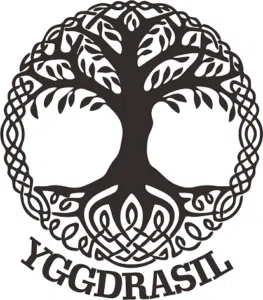
9. Gungnir Odin’s Spear
Gungnir, which translated means “swinging” is, in Norse mythology, the spear of Odin. As you might expect from a god’s weapon, Gungnir is no ordinary spear.
While swords were a more prestigious weapon, the spear was the most common weapon used by Viking warriors. Therefore, it isn’t surprising that the god of war carried a spear.
On Gungnir’s point are runes that are said to increase its aim and deadliness through magic It was forged by the dwarves sons of Ivaldi, at the request of Loki, and is a spear so well balanced and forged that can hit any target, regardless of its strength, skill or armor and according to some stories, returns to Odin just as the Mjölnir returns to Thor every time it is launched by the God of Thunder.
It is interesting to note how in Greek Mythology the construction of divine or legendary weapons is attributed to gigantic beings such as the cyclops while in Norse Mythology the forging of Gungnir or mjolnir is ascribed to small individuals such as the dwarves.
According to the myth, Odin uses it in the war of the Æsir and Vanir (the two groups of Gods in Norse mythology), throwing Gungnir on some of the Vanir Gods intent in an assembly, and crying, “Odin owns you all”.
The spear will also be used in the last battle, when the Ragnarǫk will come, to fight the wolf Fenrir.This gesture will then be repeated by the Viking warriors before the battle in the hope of gaining Odin’s protection and help during the fight.
Gungnir is considered a sign of Odin, in the form of the God of War, when represented with this symbol.
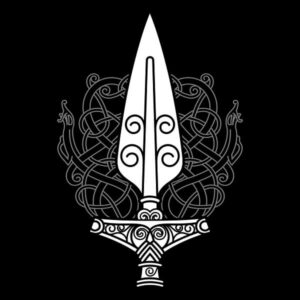
10. Svefnthorn the Most Ancient Symbol
Svefnthorn: probably the most ancient Icelandic symbol, literally means “thorn of sleep”, and also appears in Icelandic magic. Its representation is very different according to the ages and origins.
It resembles a set of four harpoons and in its most used form looks like this:
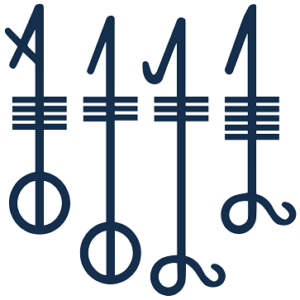
Unlike other Norse/Viking symbols this symbol seems to have never had its own definitive identity as its representation and description is different according to the ages and origins, differences were also found in the way the Svefnthorn was to be applied to someone and the effects it produced on them.
However, all citations of the Svefnthorn in literature have one thing in common: the Svefnthorn was used to put an opponent into a deep and prolonged sleep and therefore win them. In the “Saga of the Volsungs”. Odin puts the Valkyrie Brunhild, into a deep sleep. She remains asleep until Sigurd heroically comes to rescue her and wakes her up.
In the saga of King Hrolf Kraki, Queen Olof stung King Helgi with a Svefnthorn to make him lose consciousness and play a bad joke on him and his men. In this case, however, the soporific effect lasted only a few hours, after which the king woke up.
In the Gongu-Hrolf saga, Vilhjalmr placed a Svefnthorn on Hrolf’s forehead during the night, and Hrolf did not wake up until a horse shook his sleeping body the next day, causing the rune to fall. In this case, the Svefnthorn appears to be an actual physical object that can be placed on someone’s forehead, rather than a spell.
In the Huld Manuscript, an Icelandic book of spells, the Svefnthorn is described as follows: “This symbol was carved into oak wood and then placed under the head of the person you wanted to make fall into a deep sleep. He would not wake up until the symbol was removed.”
11. Web of Wyrd
One of the most fascinating concepts of the Norse culture is certainly their way of perceiving destiny. In Old English Wyrd.
It shares the same Indo-European origins as Fate according to the Greeks or karma for the Hindus, but it’s not exactly the same thing.
Because of its uniqueness, it is one of the most difficult concepts for us to understand, but it remains without a doubt one of the most fascinating.
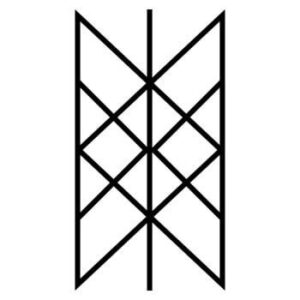
To better understand how northern peoples intended destiny we can take as reference Yggdrasil, the tree of the world, and the Well of Urd (or Fate). As we have already explained when we talked about this symbol, the nine worlds, where dwell gods, humans and giants, branch out around Yggdrasil.
Its roots sink into the Well of Urd, which is also called the Fountain of Fate. The waters nourish the tree, whose leaves then cause dew drops to fall inside the well, in an endless cycle. The well, which corresponds to the past, influences the growth of the tree, or the present.
In a circular motion of time, however, the present then returns to the past, sometimes even managing to change it! This is what the dew drops falling back into the spring show. In this way, destiny follows the course of the water, crossing Yggdrasil and then returning to its origins.
Thus, destiny is that force that causes the past to exert an influence on the present, which in turn is able to change the past, thus creating a potential new present. In the Well of Urd live the Norns, three wise women who carve into the trunk the lives and destinies of each newborn.
All creatures of the nine worlds, be they humans, gods or insects, are subject to what is inscribed in the tree. What the Norns inscribe, however, is only one of the many possible forms that the destiny of each can take.
Unlike the Fate of the Greeks, which could not be changed, the words of the Norns are not absolute. Since the present can influence the past, the Norns’ words can also be rewritten.
All living beings have, in a certain way, the power to change their own destiny and also that of others.
So to sum up the meaning of this symbol the basic concept of the Wyrd can be summarized as follows past actions continually influence and affect the future. But also as the future influences the past, all actions of all times influence each other.
The Wyrd is not motionless and immutable, it is always in continuous becoming and never repeats itself in the same way, it is not an individual destiny, but rather a network that connects every element and every creature in the universe, and knows no distinction between past and future.
12. Triquetra
The Triquetra is a figure with a deep symbolic meaning and its name comes from the union of two Latin words: tres (three times) and quetrus (made at an angle). So it can be translated as “three-cornered”,
This symbol comes from the populations of northern Europe by the Celts and it is considered one of the most ancient, dating back to 500 BC. when it was used to symbolize the feminine aspect of the divine, as it is the mother who generates life.
It represented the triple goddess: Maiden, Mother, and Crone. In this symbol, there are some interesting similarities with the Valknut, from the Viking / Germanic peoples.
During the centuries it has been incorporated into the catholic religion becoming the symbol of the Holy Trinity, the intersection of three distinct “vesica piscis” would represent Father, Son, and Holy Spirit.
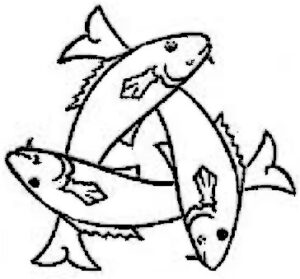
Other meanings have often been attributed to the symbol and used to represent the 3 fundamental elements: air, water and earth or the infinite cycle of life: birth, life, death or again that of time: past, present, future.
According to an Irish tradition, the Triquetra is a traditional symbol of eternal love, so for this reason, couples exchange a pendant or a ring with a triquetra to show each other love and devotion.
Nowadays, it has become a favorite design element in jewelry all around the world.
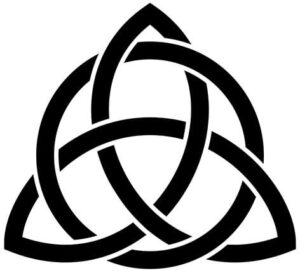
13. Swastika
Of all the Viking symbols, the swastika is definitely the one that has almost lost its true meaning.
The symbol, which was used for the consecration and blessing of Vikings and Indo-Europeans, in a way very similar to Mjölnir (it was often engraved on the handles of hammers) was illegitimately taken by Hitler and the Nazi party and, unfortunately, since then is still widely associated with this and only this, making it virtually impossible and with obvious consequences its use today.
If a person or object was (in ancient times) blessed using the swastika, they became pure, holy and lucky, exactly as was later done using the Catholic cross.
In fact, the swastika was believed to be the most significant symbol of a good luck charm by some people in the past. It was believed to take a person from a desperate and chaotic state to one of strength, prosperity, and order.
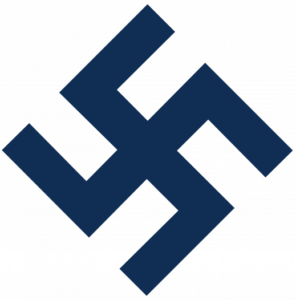
14. Huginn and Muninn
Huginn and Muninn are a pair of ravens, who served Odin, telling him everything that happened in the world and in addition to bringing messages to humans and his children semi-gods. In several works, the two ravens were depicted right next to Odin or sitting on his shoulders.
Huginn and Muninn would fly around the world during the day and return to Odin at night to tell him everything they had seen.
It was believed that because of the abilities provided by Odin, Huginn and Muninn were keen observers and could travel all over Midgard (the middle world, the world of humans to be clear) in a day, as well as speak and understand the language of humans.
This is also why some experts suggest that, Huginn and Muninn, may indeed have been projections of Odin’s consciousness. The fact that the words “Huginn” and “Muninn” literally mean “thought” and “mind” reinforces this theory.
In this sense, Huginn and Muninn are considered symbols of Odin and his powers.
As a side note, ravens were revered in Norse culture. Many Viking kings and rulers, including Ragnar Lothbrok, used ravens on their banners.
The Vikings also used ravens to find land when they sailed to unknown waters, much like young Noahs. They used to keep ravens in cages and let them out at regular intervals to find land. Once out, the crows would explore the area around the ship, to fly to land if they found it. If not, they would return to the ship again.
This is, in fact, how one of the most famous Vikings, Floki (Hrafna-Flóki Vilgerðarson) managed to find Iceland according to history. The word “hrafna” actually means “raven”.
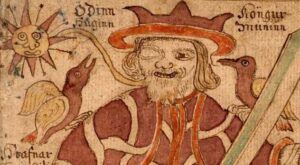
15. Troll Cross Norse Symbol of Protection
The Troll Cross is a Norse symbol of protection, related more to Swedish folklore than Viking. Although thought to be part of Swedish folklore, it was first created – as a jewelry item – by blacksmith Kari Erlands, in the late 1990s.
It is said to be a copy of a protective rune found on his grandparent’s farm, in fact, the shape of this symbol resembles that of the rune Othala in ancient Futhark, but this has not been verified and most likely it was a Bumerker, a property/house mark used in rural Norway.
It was thought to be able to protect villages from trolls, elves, and in general from black magic.
16. Sleipnir the 8-Legged Horse
One of the most frequently mentioned creatures in Norse mythology and folklore is certainly Sleipnir, the famous steed of the god Odin.
Known for his gray coat and his eight legs, he is the fastest horse that exists, able to cross the borders of the world riding the skies and seas.
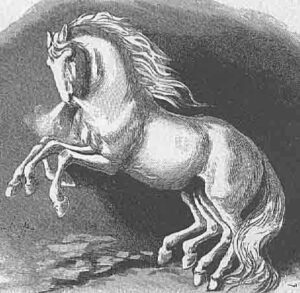
His name means “he who glides quickly”, often transporting the dead to the afterlife, going as far as the desolate territories of the lowest of the worlds, the Niflhel.
To tell the myth of the birth of Sleipnir is Snorri Sturluson in the Prose Edda
The legend tells that the gods, needing to build strong walls to protect Asgard, their kingdom, from the attacks of the giants, contacted a blacksmith who, in exchange for his services, asked for the hand of the goddess Freyja, the sun and the moon as payment.
The gods agreed, on one condition that the work would be completed by the end of winter.
The blacksmith built quickly, almost never resting, with the help of his magical horse, Svadilfari, a stallion who did more than half the work at an incredible speed.
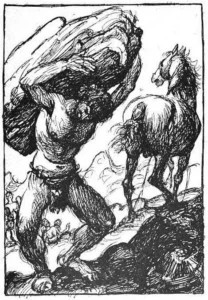
The more time passed, the more the gods’ concern grew. None of them believed that it was possible for a mortal to build those walls in the allotted time.
So, they gathered, determined to come up with a plan. Loki, the God who had allowed the blacksmith to work with his horse, was declared guilty of the situation and was forced to find a quick solution. If he was not successful, he would be tortured by the gods themselves and killed.
Then trickster Loki, three days before summer, decided to transform himself into a docile mare and, after having attracted the attention of Svadilfari, started to run through the woods, letting himself be chased for three days and three nights.
The work suffered serious delays without the help of the horse and the blacksmith, enraged, showed to the gods his true nature: what they believed to be a man was actually a giant.
Having understood the deception, the gods called Thor, the arch-enemy of giants, who hurled against him his faithful Mjöllnir, the divine hammer, which pierced him and sent him into the Niflhel.
Loki, who was transformed into a mare a few months later gave birth to a horse with eight legs, Sleipnir, magical and unique, which gave to Odin.
Many ancient civilizations before the Viking era had symbols of eight-legged horses. The symbol was used to describe the passage of a soul from life to the afterlife.
Speed, safety, luck in travel, eternal life, and transcendence are just a few of the attributes of Sleipnir, which make it a symbol especially dear to athletes, equestrians, and travelers
17. Ravens
As we have already seen previously, the raven is the sacred symbol of Odin, the god of Vikings. Warrior deity and powerful, Odin has two ravens, Huginn and Muninn, which are free at sunrise to fly around the world.
For the importance that these animals have assumed for him, Odin is often called hrafnaguð, the Raven God. Ravens are extraordinarily intelligent animals. They are among the very few creatures that recognize themselves in a mirror and are capable of structuring complex strategies for problem-solving, manipulating tools and objects.
It is no coincidence that the two ravens of Odin are called “Thought” and “Memory”: their thought, in fact, is extremely elaborate and is equipped with a deep and rare sense of memory. Ravens were often domesticated and used as both messengers and explorers.
The ability of the symbol of the raven to give victory was deeply rooted in the Viking peoples, as the bird was sacred to Odin. In addition to its totemic significance, the raven symbol probably also had psychological significance.
The Vikings associated the raven with the battlefields and massacres, so raising a banner before a clash, bearing the image of a raven, was probably a way to instill fear in the enemies invoking the power of Odin and that they would soon become food for crows.
For this reason, the banner of the raven was often used by various Viking chiefs such as the sons of Ragnarr Loðbrók during the IX, X, and XI centuries.
Although the raven contains in itself infinite opposite meanings, there is one aspect that we find in all its interpretations, regardless of culture and time: the passage.
Ravens, in fact, are always associated with a transition from one state to another. For example, they symbolize the passages from ignorance to knowledge, from life to death, from evil to good, and from night to day.
18. Wolf Fenrir
In Viking and Norse culture, the most famous wolf symbol is surely Fenrir, considered one of the most frightening monsters.
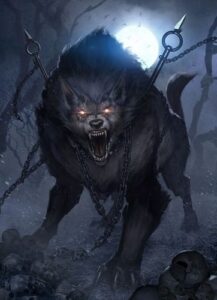
Fenrir is the son of the god Loki and the giantess Angrboða. This mythical animal is mentioned several times in the Edda. Fenrir, according to tradition, is not only a huge wolf with extraordinary strength and size, but he has inherited from his father a strong intelligence and the ability to speak.
Fenrir, since he was a young pup, proved to be a different animal from the others, in fact, he devoured so much food that he began to grow at an incredible rate. There came a time when the gods began to worry and finally decided to tie him up before it was too late, but Fenrir broke every chain.
At this point, the gods turned to the skilled dwarves to find a remedy. The dwarves created Gleipnir, a chain that looked light and silky but was unbreakable.
In the end, they succeeded in chaining the wolf, but Tyr, the valiant god of war, had to lose a hand, as the wolf only agreed to be chained if someone put a hand between his jaws, and Tyr was the only one who agreed to this test. Subsequently, the wolf will remain chained until the day of Ragnarök.
On that day, the giant wolf will manage to free himself and will march towards the final battle with his father Loki, and the side of the giants. Fenrir will devour Odin.
The wolf will then be killed by Viðarr, Odin’s son and god of silence and revenge. Wolf sacrifices were often offered to Týr because of his hand being bitten by Fenrir, but also to Óðinn for victory.
In the Norse Mythology, however, there are not only evil wolves Odin in fact used to be accompanied by two wolves Geri and Freki.
The pair of animals has been compared to similar figures found in Greek, Roman, and Hindu mythology, and may also be connected o the beliefs of the Úlfhéðnar, warriors in Norse mythology who wore wolf skins on their shoulders as a symbol of strength.
As we have seen in Norse culture, the wolf had both positive and negative associations.
19. Longship
The Vikings were great people of navigators, experts in the construction of innovative vessels and navigation in the hostile northern seas.
Whether they were merchant ships or warships, Viking vessels were built with the same characteristics: riveted construction planks, a high keel, a single mast with a large square sail, a lateral rudder and a symmetrical hull with equal bow and stern so that the ship could be maneuvered in both directions without having to rotate.
The ease with which these ships could move and steer was a great advantage in a hostile sea filled with icebergs and sheets of ice.
The hulls of the Viking ships were covered with animal skins tarred to make them waterproof and were built with overlapping planks connected to each other, so it was possible to achieve a solid outer surface and light and was sufficient an internal frameless heavy than the European boats of the time.
This construction created a hydrofoil effect, with the fast movement in the water, the hull lifted outwards, reducing resistance and further increasing speed. In addition to being faster, these lightships could be easily transported on land (for example on the strip of land between two rivers).
It is thought that the keel of Viking vessels was preserved generation after generation and that the ship was rebuilt around it, due to a mythological-religious issue and the fact that reusing a keel in good condition brought savings in time and money.
In general, a typical 22-meter ship would have required for its construction 11 masts with a diameter of about 90 cm, plus a tall mast that could act as a rudder.
In all Viking vessels, there was always an iron anchor and navigational instruments on board, such as a primitive form of the astrolabe and the “Sun Stones”, (pictures on the side) used on cloudy days to locate the position of the star and orient themselves.
It is thought that the Viking sailors became relatively adept at judging the speed and direction of the wind, knew the currents and were able to identify the moments of high and low tide, also were able to orient themselves by means of the stars also used to draw the routes.
According to the legends the Viking navigators used to bring on board ravens in cage, used in case they were lost. These animals would be able to find land again, guiding the boat and its crew to safety. Viking navigation techniques were not very complex and relied mostly on luck and courage.
Drakkar
The warships, the Drakkar, were a bit narrower than the commercial ships, the Knarr, and had a greater number of oars to increase their speed. The oarsmen had no special seats, but simply sat on the beams that formed the inner framework of the boat or on the crates on board.
As a rule, the holes of the oars were covered with wooden discs, to which, in case of particularly dangerous expeditions, were also hung shields to provide additional protection from attack.
The Viking square sail usually measured around 30 square meters. On the prow of the Drakkar was carved the head of a dragon or snake with the purpose to protect the ship from the sea monsters, present in Norse mythology, and frightening the enemies.
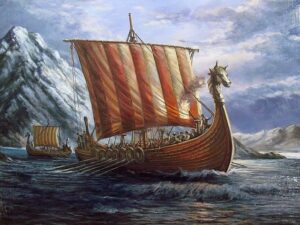
Snekke
There was a very common type of Drakkar called Snekke designed for navigation between the fjords as it was perfect for travel in shallow waters.
The Snekke was a small boat about 17 meters long and 2.5 meters wide that could carry a crew of about 25 men. The largest Drakkar found so far measures 35 meters in length and was discovered at Roskilde in Denmark.
Knarr
The merchant ships, the Knarr, (pictures on the side) were used to transport goods such as walrus ivory, wool, timber, hides, slaves, honey and weapons. They were also sometimes used as supply ships for merchants and warriors during their travels in the Baltic and Mediterranean Seas.
The Knarr’s usual routes included Iceland, Greenland, the British Isles and mainland Europe. These boats had a shorter and wider hull than the Drakkar and therefore a greater possibility of cargo, consequently they reached a lower speed of travel than the warships. The crew was generally composed by 8-10 men.
20. Bears
As we have seen before, in Norse mythology there are often many types of animals such as ravens, wolves, snakes, boars, horses, goats. But, surprisingly, it is quite difficult to find cases of bears in the various myths handed down by the Nordic peoples, these animals rarely appear in Norse Mythology.
Considering the fear but also the respect that the Vikings had for these animals, the almost total absence of bears in Norse mythology is quite puzzling.
Often during visits to the human world, both Odin and Thor take on the appearance of bears as a disguise. Bears symbolize wisdom, strength, and healing that bring balance to the seen and unseen world. While male bears usually represent masculinity, female bears serve as symbols of femininity.
In the end, the most important contribution of bears in Norse mythology turns out to be that of the ingredient used by the elves (the sinews of a bear) for the realization of Gleipnir the magical binding used to chain the wolf Fenrir.
From archaeological and historical findings it seems that bears were kept as pets by the Vikings.
Who were the Berserkers?
Another reference to bears is that of the Berserkers, who wore bear pelts as a symbol of their warrior status. Berserk means “bearskin” in Old Norse. More than a population it was probably a chosen corps of the Viking kings (they constituted the guard of Harald I in 872-930).
Loyal to Odin, the god of war, and very brave in battle, the Berserkers were famous for their savage treatment of their enemies.
Caution, however, is called for, because the information about the Berserkers does not come from historical sources but exclusively from Scandinavian and Germanic legends.
Unlike other warriors, these men wore no armor at all, only entering battle dressed in the skins of wolves and bears, exploiting the natural human fear of ferocious beasts.
Berserkers fought so fiercely, it was believed they were actually able to shape-shift and transform into wild predators.
In preparation for battle, berserkers would enter a state of near insanity that endowed them with superhuman strength.
The condition would begin with violent shudders, followed by their swollen faces and changing color. They were then seized by fits of rage that grew in intensity rapidly until they exploded into uncontrollable anger.
The Berserkers would scream and wail like wild animals, beating on their shields with superhuman strength. When the battle began, they would quickly advance in a state of incredible madness.
They seemed to literally lose all human reason, reducing everything to a terrible chaos. As they passed by, friend or foe to them made no difference, they would attack the first ones they saw. They were so strong, that no one and nothing could ever resist their assault.
In this frenzied state, they were oblivious to their own pain. Even if, in rare cases, they were mortally wounded, they would continue the fight until the opponent was dead.
Even their appearance instilled terror. They are described as hideously ugly, giant, troll-like men. Berserks were closely connected to the god Odin and were believed to have the power to dampen any weapon attack with a glance.
In addition, it was often told that it seemed that the animal skins they wore deflected blows.
At least two Danish kings, Halfdan (c. 810-860), and Harald (c. 850-933), are reported to have used these men of such destructive abilities among their shock troops.
Unfortunately, reference is also made to sad events in which the berserkers, caused death and destruction in their own communities.
The Norse sagas report that they often had fits of uncontrollable fury and wreaked havoc in peaceful Viking villages, robbing, and looting, destroying property and livestock, killing the people, and kidnapping young and beautiful women.
Of course, in the saga the Viking hero would have to speed up his recovery time, becoming lucid and normal again.
There was only one way to defend himself against berserkers. After each episode of frenzy, they would remain exhausted, in a state of extreme weakness that lasted from one to several days. These were the only times they could be defeated.
Modern scholars have offered several theories to explain these fits of rage in Berserkers: consumption of hallucinogenic plants, such as agaric mushroom or swamp myrtle, drinking large amounts of alcohol, self-induced hysteria, epilepsy, mental illness or genetic defects.
In 1015 AD, King Erik was said to be a berserker.
Unwittingly, berserkers left an interesting legacy: their name became a commonly used expression: “to go berserk”, meaning to lose all control over oneself.
21. Dragons
According to Norse mythology, dragons are fantastic creatures and possess special properties, such as being able to speak many languages, even the language of man; they use these properties to fight enemies and make their own blood magical; legends speak of healing powers and the gift of invulnerability.
Scandinavian mythology identifies four different species of dragon: the black worm, the puk, the lindworm and the firedrake
- The black worm, it is said, slept protecting its treasure but one night a man stole the precious gold of the sleeping creature. The dragon woke up and, roaring, put the thief to flight and then disappeared into the ground with his precious treasure.
- The puk is a domesticated dragon, small in stature and with wings. The stories tell that this type of dragon brings luck and prosperity to the family that hosts it, assuming benevolent attitudes towards those who appreciate its qualities: it is very well known in Estonian, Latvian and Germanic mythology.
- The lindworm (or lindorm) is imagined as a monster-serpent (remember the Basilisk in Harry Potter and the Chamber of Secrets, a sea monster over twenty feet long halfway between snake and dragon) with fiery eyes, claws, fangs, and sometimes wings. The dragon is also known as the creature of the underworld, bringer of ominous events and avarice.
- The firedrake is a winged, fire-eating dragon that lives in dark secret caverns. The best-known specimen of the Scandinavian dragons, the fire dragon is the legendary creature faced by the hero Beowulf; furthermore, its characteristics inspired J.R.R. Tolkien to create Smaug, the evil being in The Hobbit.
The most famous Dragons in Norse Mythology
- The Midgard Serpent, also known as Jormungandr (or Miðgarðsormr), born of a giantess, is the son of Loki, the god of fire and chaos. According to legend, Odin threw Jormungand into the human ocean and the serpent dragon grew to be the size of the Earth. It is said that at the end of the world, during the last battle (Ragnarǫk), Jormungand will clash with Thor, the god of lightning: deity and serpent-dragon will both die.
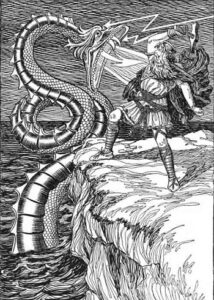
Thor fighting Jörmungandr
- Fafnir was a dwarf, son of the magician Hreidman. The myth tells that, when Loki killed by mistake the dwarf’s brother, Otr, who had turned into an otter to fish, Loki for the error committed decided to compensate Hreidman giving him a magic ring as a gift (but it was cursed as stolen). So a fratricidal war broke out to get possession of the magic object and at the end Fafnir had the better, but his avarice transformed him into a dragon. With time he became the keeper of many riches, attracting the envy of Regin, another brother, and Sigurd, his adopted nephew. Sigurd wounded Fafnir with the noble sword Gramr and then immersed himself in his blood, with magical properties, and was immediately able to understand the language of the birds who warned him that Regin wanted to kill him, so Sigurd killed Regin first and left with the treasure.
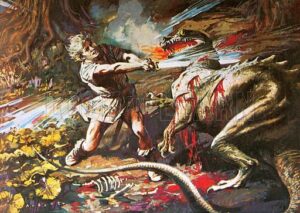
Sigurd against Fafnir by Alberto Salinas
- Nidhogg is an enormous serpent that lies beneath the World Tree in the underworld, gnawing on one of its roots. When Ragnarok arrives, Nidhogg is said to arise and take all the dead with him to face the final battle.

Nidhogg
22. Boars
The boars are very present in Norse Mythology, as symbols of fertility so let’s see some examples:
Gullinbursti (Golden Bristles) forged by the dwarfs Sindri and Brokkr Brokk offered it to the god Freyr, explaining that this boar would run on land as in sea faster than a horse, day and night thanks to the light shed by the gold of its bristles.
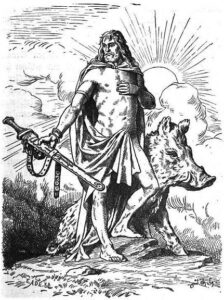
Gullinbursti by Johannes Gehrts
Sæhrímnir its meat is cooked every day to feed the Aesir and the Einherjar, after being eaten, the next day it comes back to life to serve a new meal.
Hildisvíni (Battle Swine) boar ridden by the goddess Freyja, sister of the God Freyr, this boar was made by the dwarves Dáinn and Nabbi
The fierce wild boar represents, undoubtedly, the symbol of strength and fertility and is the most sacrificed animal to Freyr and Freya for this reason.
Moreover, the Norse warriors, especially the Vikings, who wished to obtain in battle the protection of the goddess of love Freyia, used to wear boar furs and helmets that represented the boar. The boar in coins was engraved as a symbol of vigor and power too.
23. Cats
In Norse mythology, cats were often associated with the goddess Freya. They were one of the goddess’s favorite animals, she, in fact, had two gray cats that fought at her side and pulled her chariot.
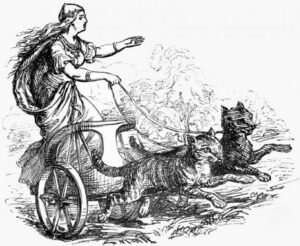
They were thought to be good luck promoters for newborns. Cats were often sacrificed in rituals and their fur was used to line gloves and other clothing, but, at the same time, it was considered bad luck to kill a cat. They were kept as pets to keep mice at bay.
Cats are also featured in the story of the wolf Fenrir. When Fenrir broke both the chains with which the gods had tried to immobilize him, they turned to the dwarves, who made a kind of rope called Gleipnir, which among other things was made by the sound of a walking cat, and thanks to this rope, which looked weak, they then managed to bind Frenrir.
The other story of the Norse mythology in which we find the presence of a cat is that of Thor when he is challenged by the giant Útgarða-Loki to lift a cat that looks light, but is actually very heavy and of which Thor can barely lift a leg, as it was actually the Midgard serpent disguised as a cat through magic.
Cats were also brought aboard Viking ships. As shown by some archaeological evidence. Cats were an integral part of the Viking peoples whether they were used in the house as pets or for hunting rats or went with them in raids
24. Dogs
Garm, in Norse Mythology, is a dog that watches the gates of the realm of death, Helheim, a kind of hell in the Norse world.
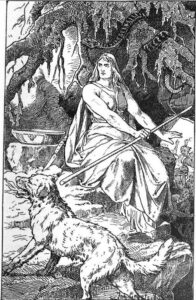
Very little is known about this dog, as references to him are few and scattered among them.
What we do know about Garm, besides guarding the entrance to Helheim? Hela’s hound would have been released in Ragnarok, along with the rest of the imprisoned and bound monsters, to destroy the world of men. He and the god Tyr would collide, resulting in the death of both.
He is depicted as a large, bloodstained hound, chained in his cave, Gnipahellir. His size, strength and ferocity were legendary.
The surviving myths do not give the dog an origin or explain why he is chained to Gnipahellir.
In one tale, while Odin is on his way to Vala to learn the future of his son Baldr, the dog pulls at his chains and howls as the god passes and enters Hela’s realm.
In one of the poems of the Poetic Edda, the Grímnismál, it is said that Garm is to the canines what Odin is to the gods and what Yggdrasil is to the trees, that is, the most exceptional, the greatest among them, the primordial, Garm is called “the best of hounds” by Odin when he lists the best things in all the cosmological realms.
It seems unlikely that he would refer to Garm in this way if Garm were another name for Fenrir.
In the Völuspá, another eddic poem, Hela’s dog is mentioned as one of the signs of the beginning of Ragnarok. It will be his scream that will start everything, break his chains and, for the first time, leave the kingdom of Hel and leave for Midgard.
Tyr will fight Garmr and they will kill each other in the great battle at the end of the world.
Is Garmr a dog or a wolf? Are he and Fenrir the same beast?
While in Grímnismál Garm is referred to as a dog, in the Völuspá he is said to be a wolf.
The confusion stems from the fact that another of the events in Ragnarok mentions the escape of the wolf Fenrir, who had been bound by the gods and left in a remote swamp so that he would not devour the cosmos.
The two accounts of bound wolves being released at the same time inevitably lead to the question of whether Fenrir and Garm are ultimately the same creature.
This may be supported by the fact that while the gods and forces of chaos fight during Ragnarok, the god Tyr is said to engage Garmr in single combat.
Given that Tyr had previously tricked Fenrir into binding him with an unbreakable chain, it would make sense that the two would meet for revenge, making it likely that the wolf Tyr will fight during Ragnarok will be none other than Fenrir.
However, some experts in Norse mythology have also linked Garm to Hela’s hound mentioned in the Edenic poem, Baldrs Draumar. Here the dog is heralded in passing; chained in his cave, Gnipahellir, he barks at Odin as the god rides into the underworld.
The symbolism of caves to represent the underworld in mythologies around the world makes the suggestion that Gnipahellir is an entrance to the underworld and Garmr its guardian not unreasonable.
Whether or not Garm and Fenrir are the same beast, they appear to be creatures associated with the underworld and the forces of chaos that are unleashed to aid in the destruction of the world. The exact differences between these figures are very ambiguous, so it is not possible to say for sure if they are the same beast or if they are different.
Probably the figure of Gram has been added to the story of Ragnarok only afterward by other writers in order to make the story more dramatic.
In the large ship burials and individual graves of the Viking era, skeletons of dogs were often found; the reason why they put a dog in the grave together with its owner may have been to provide a guide for the dead, being, in Scandinavian myth and legend, the dog the guardian of the underworld.
Dogs also, played an important role in the daily life of the Scandinavian villages. They were appreciated both for their companionship and their work qualities and the farmers who could afford it, kept one for the control of the livestock and for hunting.
Shop Viking Jewelry
Finding the ideal piece of Norse Jewelry can be time-consuming and challenging, especially if you lack inspiration or don’t know where to look. Don’t worry Surflegacy, has you covered.
We have a wide range of Viking Jewelry in various styles, shapes, colors, and materials, to accentuate your Viking spirit and look.
Whatever you wear, you’ll find the ideal trendy piece to complement your wardrobe. Our jewelry is designed to be worn every day, no matter where you go or what season is. Are you ready to step up your wardrobe game?

